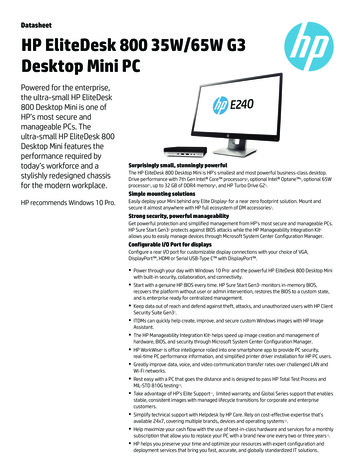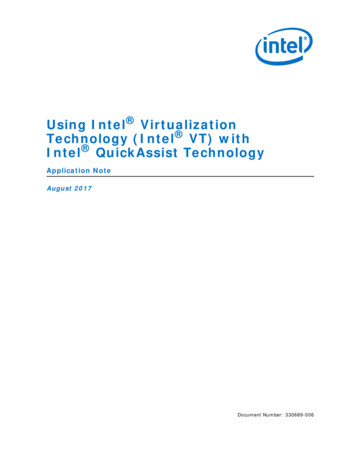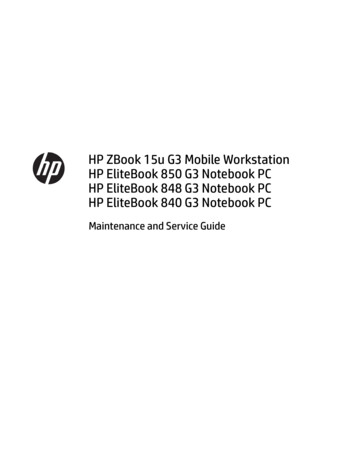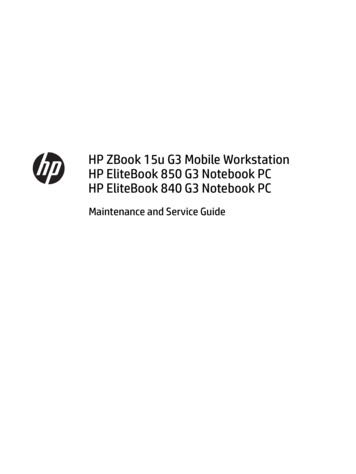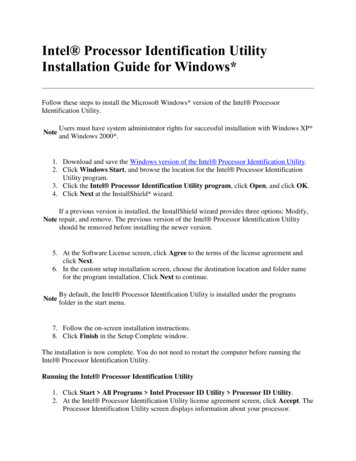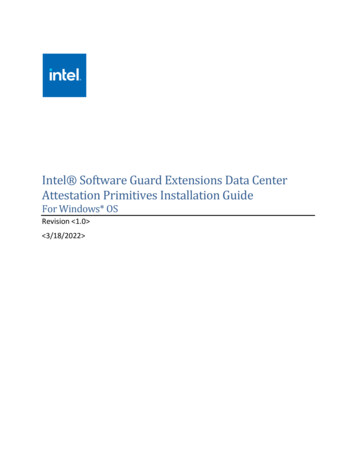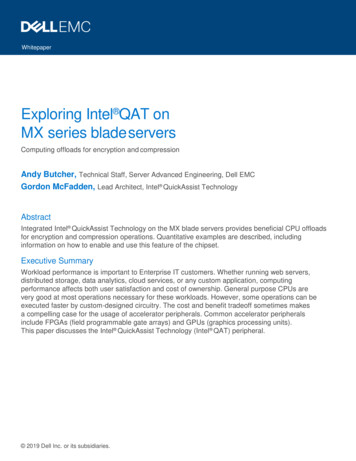
Transcription
WhitepaperExploring Intel QAT onMX series blade serversComputing offloads for encryption and compressionAndy Butcher, Technical Staff, Server Advanced Engineering, Dell EMCGordon McFadden, Lead Architect, Intel QuickAssist TechnologyAbstractIntegrated Intel QuickAssist Technology on the MX blade servers provides beneficial CPU offloadsfor encryption and compression operations. Quantitative examples are described, includinginformation on how to enable and use this feature of the chipset.Executive SummaryWorkload performance is important to Enterprise IT customers. Whether running web servers,distributed storage, data analytics, cloud services, or any custom application, computingperformance affects both user satisfaction and cost of ownership. General purpose CPUs arevery good at most operations necessary for these workloads. However, some operations can beexecuted faster by custom-designed circuitry. The cost and benefit tradeoff sometimes makesa compelling case for the usage of accelerator peripherals. Common accelerator peripheralsinclude FPGAs (field programmable gate arrays) and GPUs (graphics processing units).This paper discusses the Intel QuickAssist Technology (Intel QAT) peripheral. 2019 Dell Inc. or its subsidiaries.
Table of contents1. Introduction . 31.1 Encryption and Key Generation . 31.2 Data Compression and Decompression . 31.3 Software Licenses for Intel QAT in PowerEdge MX . 31.4 Software . 42. Intel QAT on MX7000 . 52.1 Lab Setup . 53. Example 1 – Compression . 63.1 Background – Platform Hardware and Capability . 63.2 Software Features – QATzip . 63.3 Programming Example . 73.4 Example Software stack . 83.5 Experiment Results . 84. Example 2 – IPsec . 94.1 Lab Setup . 94.2 IPSec Performance Results . 95. Conclusion . 106. Appendices . 106.1 Qzip and Gzip commands . 106.2 Example installation using yum – QAT and QATzip . 106.3 Server Setup for Traffic Generator . 116.4 Server Setup for the Tunneling Server . 126.5 VPP Configurations For OpenSSL . 136.6 VPP Configurations For AESNI . 146.7 VPP Configurations For Intel QAT . 156.8 VPP Common IPSec Configuration for OpenSSL/AESNI/Intel QAT . 166.9 VPP Common Settings – Huge Pages . 176.10 Trex Configuration File . 177. Acknowledgements . 188. References. 182 QAT Whitepaper 2019 Dell Inc. or its subsidiaries.
1. IntroductionPowerEdge MX is the first Dell EMC server to offer a software licensing option to enable Intel QuickAssist Technology.It provides a software-enabled foundation for security, authentication, and compression, and significantly increases theperformance and efficiency of standard platform solutions. This paper will explore uses of Intel QAT with two examples.1.1 Encryption and Key GenerationMany users will be familiar with the “https” prefix on frequently-visited websites. Behind all of these secure websitesis an implementation of TLS (transport layer security) or its predecessor SSL (secure sockets layer). Each protocol entailsa “handshake” between the client and server that establishes authenticity of the server and creates a session key forencrypting the exchanged data. These Public Key Encryption (PKE) algorithms, historically performed by software,can be offloaded from the CPU into the Intel QAT engine for providing significant performance gains for Web Server,Content Delivery Networks, eCommerce, VPN, Firewall or Security Load Balancer and Wan Acceleration solutions.1.2 Data Compression and DecompressionUsers of compressed file formats will be familiar with the benefit of another function provided by Intel QAT. Likecryptography, compression and decompression can be compute-intensive functions. Intel QuickAssist Technology(Intel QAT) is comprised of acceleration engines for data compression as well, yielding faster performance, lower latencyand higher throughput for software and systems that rely on compressed data such as storage, web compression,big data, or high-performance computing (HPC).Compressing data before it is stored on a hard drive provides the dual benefit of reducing the time to complete both writesand subsequent reads, and increasing the amount of data that can be stored on the drive system.Compressing data before transmission over a network improves overall network utilization by reducing the numberof TCP/UDP segments and as a result the number of IP packets. This allows more data to be sent and receivedwithout the need to expand the network interfaces.In both of these examples, the benefit is achieved by compressing and decompressing data before it is consumedby a slower component in the compute infrastructure.1.3 Software Licenses for Intel QAT in PowerEdge MXIntel QAT has a long history with the deliveries of the 8920 model and the subsequent 8955 on PCIe cards. In the Intel Xeon Processor Scalable Family, Intel is making the next generation of Intel QAT available with significantly improvedperformance in a chipset-integrated version. Dell EMC is offering hardware-enabling licenses for chipset Intel QAT on theMX series blade servers (MX740c and MX840c). These licenses can be installed without the need to add hardware to thesystem and occupy slots. Depending on the license level installed and the performance level desired, the chipset basedIntel QAT will be programmed to offer the bandwidth performance as defined below, mimicking the performance of thelatest model 8960 and model 8970 PCIe cards. The licenses are installed through the iDRAC license manager.QAT licenseCompressionEncryptionRSA40G ‘mid-range’28 Gb/s40 Gb/s40K Ops/s100G ‘top performance’65 Gb/s100 Gb/s100K Ops/s3 QAT Whitepaper 2019 Dell Inc. or its subsidiaries.
1.4 SoftwareSoftware for the Intel QuickAssist Technology is provided through the Intel open source site.1 The applicable driversare associated with the C62x chipset. Application and library examples are posted on 01.org along with the Quick StartGuide API Programmer’s Guide and other useful collateral allowing users to build upon these open source libraries andexamples or build their own applications. Release notes identify operating system compatibility.Alternatively, the software can be installed onto a Linux system with an RPM manager such as yum, as shown inAppendix section 6.2. In this example, Intel QAT and its companion application and library QATzip were installed.1.4.1 DPDK (Data Plane Development Kit)An open source project consisting of a set of libraries and drivers for fast packet processing, DPDK employs PMDs(Poll Mode Drivers) to interact with user space software, avoiding latency expensive context switches between kernel anduser space. Instructions on installing the Intel QAT PMD can be found on the DPDK web site.2 Using DPDK, performancebenefit has been demonstrated for IPsec (Internet Protocol Security), which provides security at a lower level in theprotocol stack than TLS. For further reading on IPSEC, see the Getting Started Guide3 and Sample application usage.41.4.2 Compression and DecompressionThe primary vehicle for application development or application integration for data compression and decompression forLinux and Windows Server is QATZip, which is a user space library that produces data in standard gzip format. See themost recent release notes for the drivers and the API application guides for more information on data compression.4 QAT Whitepaper 2019 Dell Inc. or its subsidiaries.
2. Intel QAT on MX7000This section includes several examples of Intel QAT applications, but this list of potential uses of Intel QAT is by nomeans exhaustive. Drivers and APIs are available for custom applications that require encryption or compression.Not included in this section is the NGINX web server, which has been integrated with Intel QAT encryption and PKEfor superior performance measured in connections per second. Also, the commonly used encryption library Opensslhas been modified to utilize Intel QAT.2.1 Lab SetupThe basis for these experiments was the MX7000 series blade server product line. The blade chassis hosts eighttwo-socket sleds in a 7U space, depicted in Figure 1. For the compression experiment, only one sled was necessary.For the IPSec experiment, two blades were connected through the IOM (input/output module, which serves as theaggregate networking switch for the blades in the chassis). In both cases, an MX740c was used, depicted in Figure 2.It should be noted that there are many other beneficial applications of this technology, as stated (for example,web server applications that offload key exchange and encryption).Figure 1 – MX7000 chassisFigure 2 – MX740cThe pertinent internal connections are represented in Figure 3 and Figure 4. Each sled plugs in directly to the IOMs;there is no midplane. This ensures signal integrity for speed upgrades well into the future. Fabric A was used as the“east-west” connection between the two blades in the IPSec experiment.Figure 3 – MX7000 components5 QAT Whitepaper 2019 Dell Inc. or its subsidiaries.Figure 4 – Fabric A and B Interconnect
3. Example 1 – Compression3.1 Background – Platform Hardware and CapabilityThe latest generation the Intel QAT device provides three separate PCIe end-points, each with 10 compression/decompression engines. In the Dell EMC MX740c, the device is integrated into the Intel C62x Chipset Platform HubController (PCH) and is connected to the CPU with a 16-lane PCIe3 link. High speed DMA (Direct Memory Access)transactions are used by the engines to transfer data. The compression engines support the creation of both staticand dynamic Huffman headers. Various search depths provide access to increased compression ratios. Both Adler32checksum and the CRC32 hash are supported.3.2 Software Features - QATzipQATzip is built on the Intel QAT software interface, providing additional features and capabilities, as well as beingfocused on ease-of-use. QATzip initializes hardware resource on the first call, eliminating the need to initialize the QATdevice separately. If QATzip is installed on a platform that is not accelerated, it will seamlessly use software libraries toprovide compression services. This allows an operator to install a common software stack on a set of platforms with orwithout Intel QAT enabled. QATzip was designed to work in multithreaded environments, potentially with a largenumber threads starting and stopping throughout a workload’s life cycle. To support multithreading, QATzip: intelligently acquires instance and memory resources each time a QATzip API is invoked. A single lightweight lockis used to acquire resources.On subsequent operations, the thread will attempt to acquire the same resources first. Thus, if there are fewerthreads than resources, then there will be no lock contention. Releases the lock on the instance and memory resource, allowing them to be used by a different thread. Registers a termination function, allowing the last thread that terminates to free the memory resources back to theoperating system, and release the Intel QuickAssist Technology instances.These actions allow a large number of threads to seamlessly and efficiently share a small number of endpointsand engines.For environments with high network traffic or file caching, where system memory contention is likely to occur, the memorydriver that ships with Intel QAT can be configured to consume memory from allocated huge pages.QATzip is optimized for larger files and can be configured to use software-based compression if the clear-text size is smallenough that the trip to the accelerator and back would outweigh the benefits of offloading the job to the accelerator.By including RFC compliant gzip headers with extensions as illustrated in Figure 5, the QATzip library can effectivelyperform parallel decompression on file portions, concurrently taking advantage of the multiple engines to providehigh data throughput.Figure 5 – QATzip header extensions for increased decompression performanceDuring the compress operation, the input is divided into chunks – default size is 64 kilobytes – and passed to thecompression engine in parallel. Each gzip structure contains the source and destination size, meaning they can besimultaneously decompressed. The extra header adds 12 bytes. In most circumstances, this does not materially impactthe compression ratio. This multi-gzip structure complies with RFC 1952 and is correctly decompressed by both QATzipand software decompression utilities. QATzip can be configured to produce a single gzip header without the extension,which is used in webservers, such as Nginx, for consumption by browsers.6 QAT Whitepaper 2019 Dell Inc. or its subsidiaries.
3.3 Programming ExampleThe QATzip has been carefully designed to provide a simple programming API. The following code segment is complete:[gmcfadde@localhost small] cat MakefileINC DIR /opt/intel/QATzip/include/smallQz: main.cgcc -g -O0 -I (INC DIR) main.c -o smallQz -lqatzip[gmcfadde@localhost small] cat main.c#include stdio.h #include stdlib.h #include “qatzip.h”int main( int argc, char *argv[ ] ){int rc;unsigned int i len, o len;unsigned char *in, *out;QzSession T sess {0};As can be seen, there is no explicit requirement to initializeaccess to hardware. This is taken care of in the firstQATzip API call.Applications can explicitly initiate and setup the QATziplibrary to configure specific session parameters used inthe compress and decompress calls. Examples areshown in Table 1.ParameterRangeDefaultHuffmanEncodingDynamic StaticDynamicHeadersNone gzip gzip withextenstionsgzip withextensionsi len 128*1024;o len 128*1024;in malloc(i len);out malloc(o len);if ( NULL in NULL out ){printf( “memory failure\n” ); return 2;}rc qzCompress( &sess, in, &i len, out, &o len, 1 );printf( “In len %d, out len %d, rc %d\n”, i len, o len, rc );return rc;}[gmcfadde@localhost small] [gmcfadde@localhost small] touch main.c[gmcfadde@localhost small] makegcc -g -O0 -I/opt/intel/QATzip/include/ main.c -o smallQz -lqatzip[gmcfadde@localhost small] ./smallQzIn len 131072, out len 234, rc 0[gmcfadde@localhost small] Compression1-9Level1Size of datapassed tohardware1 KB - 512 KB64 KBMin size forhardware128 bytes andhigher1024 bytesNoteslevel nine invokesa software compressionalgorithm for the bestpossible compressionrationo upper limitTable 1 – Selected QATzip session parametersFinally, the QATzip library includes its own allocation and free APIs – qzMalloc() and qzFree(). If appropriate,an application can allocate memory that will be compressed or decompressed using these APIs. qzMalloc will returnedpinned memory if available. This will lead to improved latency as the data is already in DMA-friendly memory and will nothave to be copied. The qzCompress and qzDecompress APIs accept both pinned memory and regular memory withoutthe caller having to indicate which type is being used in a specific call.7 QAT Whitepaper 2019 Dell Inc. or its subsidiaries.
3.4 Example Software stackFigure 6 shows the integration of QAT into NGINX, providing bothencryption and compression for the web server. This diagram puts theQATzip library in context, showing its relation to application softwareand the driver.3.5 Experiment ResultsThe results shown in Table 2, Figure 7, and Figure 8 were obtained onan MX740c blade server with two Intel Xeon Gold 5117 CPUs runningat 2 GHz. There was 281GB of RAM on the machine, and files werecached so disk operations would not skew the results. The operatingsystem was Red Hat Enterprise Linux 7.6. The files under test werecreated from arbitrary data. Intel has already published results fromthe Calgary Corpus dataset, so we chose to confirm performancewith randomly selected binary and text data,1 which was also useful increating large files so the performance could be easily observed overan extended time. For the comparison, gzip performance was collectedalongside QATzip performance. We chose a compression level (4) thatoffered the most similar ratios. The times were captured as the total of“user” plus “system” time for the threads executing the compression.Commands used are shown in Appendix section 6.1.gzip/gunzipFigure 6 – QAT integration into theNGINX web serverQATzipTest fileSizeComp. ratiogzipcomp.time(s)gzipdecomp.time (s)comp.ratioqzipcomp.time(s)qzipdecomp.time (s)% accel.file #11GB1.8616.765.891.871.751.0889.6%file #21GB8.4538.288.909.162.432.0893.6%file #31GB1.2543.179.611.262.592.2994.0%file #41GB1.0339.746.461.032.712.3293.2%Table 2 – Compression and Decompression comparison between a software-only (CPU) operation vs. a QAT assisted operationFigure 7 – Compression time comparisonFigure 8 – Decompression time comparison1 The exact content was less important in this experiment as investigating some variety of compressible vs. uncompressible data. For this, some .tar files for FPGA tool installers were used (notcompressible), and there was some text data (source code) mixed with the binary data. The data that was compressible is evident in the results.8 QAT Whitepaper 2019 Dell Inc. or its subsidiaries.
4. Example 2 – IPsecIn this experiment, the performance benefit of offloading encryption to the Intel QAT device in a simulated VPN tunnel isdemonstrated. The tunneling machine, running VPP,6 was exercised with a traffic generator running TRex. To perform theIPsec encryption, three methods were compared, employed by VPP at the tunnel: 1) openssl library without offload2) Intel AES-NI, and 3) Intel QAT offload.4.1 Lab SetupFigure 10 shows the lab setup. The MX740c machines were configured asfollows: Tunneling Server: Intel Xeon Gold 5117 CPUs @ 2GHz, 30GB memory,Intel Ethernet 25G 2P XXV710 Mezzanine card, RHEL 7.6 Traffic Generator: Intel Xeon Gold 6146 CPUs @ 3.2GHz, 376GB memory,Intel Ethernet 25G 2P XXV710 Mezzanine card, RHEL 7.6The p1p1 and p1p2 are attached to Fabric A1 and A2 switches respectively inthe MX7000 chassis.The configuration files and procedures for this experiment are detailed inthe Appendices, and additional reference material and links are listed in theReferences section.Figure 9 – Test setup for the IPsecperformance measurement4.2 IPSec Performance ResultsThis section provides summary of results observed. The graph in Figure 9 shows that the benefit of offload, measured bythe data throughput per second, increased with packet size. This is intuitive because the overhead of the offload operationis incurred more times per unit of data with the smaller packets. The figures measured by TRex are reported in Table 3.Figure 10 – IPsec tunnel performance for encryption options9 QAT Whitepaper 2019 Dell Inc. or its subsidiaries.Packet Size(Bytes)Data Rate(With IPSecOpenSSL) GbpsData Rate(With IPSecAESNI) GbpsData Rate(With IPSecIntel QAT) 8113000.7684.3415.9114000.7453.7817.24Table 3 – Resulting data throughput for variousencryption calculation methods
5. ConclusionAcceleration and offload functions of Intel QuickAssist Technology (QAT) demonstrated in this paper are encryption/decryption and compression/decompression. IPsec tunneling was used as a workload to show the benefit of encryptionand decryption offload. QATzip was used to demonstrate the performance of accelerated compressionand decompression. In both cases, faster performance was offered by offloading operations onto the QAT engines.Other workloads not shown are also beneficiaries of this technology, including web server applications.6. Appendices6.1 Qzip and Gzip commandsgzip -4 -k ‘” filename”gunzip -f ‘” filename”qzip -L 4 -k ‘” filename”qzip -d -k ‘” filename”6.2 Example installation using yum – QAT and QATziproot@gm-fed-28 ]# cat /etc/yum.repos.d/intel-qat.repo[intel-qat]name Intel QATbaseurl https://download.01.org/QAT/repo/gpgcheck 0[root@gm-fed-28 ]# yum install QATzipDependencies resolved. PackageArchVersionRepositorySize Installing:QATzipx86 640.2.5-02intel-qat40 kInstalling dependencies:QATx86 641.7.0-450b34intel-qat4.5 MTransaction Summary Install 2 Packages Verifying: QATzip-0.2.5-02.x86 64Verifying: QAT-1.7.0-450b34.x86 641/2Installed:QATzip.x86 64 0.2.5-02Complete![root@gm-fed-28 ]#10 QAT Whitepaper 2019 Dell Inc. or its subsidiaries.QAT.x86 64 1.7.0-450b342/2
6.3 Server Setup for Traffic GeneratorThe section describes the steps required to run TRex on the traffic generating server. See links for additional informationon DPDK and getting started with IPsec.9 There is additional reference material for TRex online.101. Disable the network ports being used for DPDK:cd /etc/sysconfig/network-scriptsifdown p1p1ifdown p1p2service network restart2. Download and untar DPDK in directory “dpdk”.cd /home/dellgit clone http://dpdk.org/git/dpdk3. Compile/Setup DPDKcd /home/dell/dpdkexport DESTDIR x86 64-native-linuxapp-gcc destdirmake T x86 64-native-linuxapp-gcc install -j1004. Insert DPDK UIO driver into Kernel:modprobe uioinsmod x86 64-native-linuxapp-gcc/kmod/igb uio.ko5. Bind DPDK UIO module with PCI device. (Note: This step is generally not needed as Trex binds to DPDK itselfwith information from its configuration file with specified PCIe ID’s.)./usertools/dpdk-devbind.py -b igb uio 0000:3b:00.0./usertools/dpdk-devbind.py -b igb uio 0000:3b:00.16. Generate Trex configuration file.cd /home/dell/trex-core/scripts./dpdk setup ports.py -iFollow the prompts to generate trex cfg.yaml.This file needs to be generated only once, or one can use the file generated already.7. Open 2 Linux terminals8. On First terminal, launch Trex Traffic generator:cp -f trex cfg.yaml /etc/cd /home/dell/trex-core/scripts./t-rex-64 --cfg /etc/trex cfg.yaml -i9. On 2nd terminal, launch Trex Console:cd /root/my home/trex-core/scripts./trex-console10. In Trex Console, execute following commands to start Trex traffic:portattr -a --prom onstart -f qat tests/udp 1pkt simple payload size .py -m 25gbps -p 0 --forcestop -aWhere: payload size varies from 100-1400 bytes.Trex traffic files with it are already created within qat tests directory.11. Network traffic for each of the tests can be started and stopped with commands in previous step.11 QAT Whitepaper 2019 Dell Inc. or its subsidiaries.
6.4 Server Setup for the Tunneling ServerThe section describes the steps required to run VPP on Tunneling Server that performs the IPsec encryption.A command line reference for VPP can be found online,11 with additional reference material from Intel.126.4.1 Install and Enable Intel QATThese steps enable Intel QAT on then Server-Sun.1. Check for PCI devices (information only)[root@sun dell]# lspci grep processor60:00.0 Co-processor: Intel Corporation C62x Chipset QuickAssist Technology (rev 03)61:00.0 Co-processor: Intel Corporation C62x Chipset QuickAssist Technology (rev 03)62:00.0 Co-processor: Intel Corporation C62x Chipset QuickAssist Technology (rev 03)2. Configure and compile QATcd /home/dell/qat./configure --enable-icp-sriov hostmake -j10make installlspci -d:37c9 -k3. Repeating Step 1 will show the Virtual Functions rendered by QAT install step (information only).6.4.2 Set and Run VPPThese steps provide information on how to run VPP with OpenSSL, Intel AESNI and QAT.1. Disable the network ports being used for the DPDK:cd /etc/sysconfig/network-scriptsifdown p1p1ifdown p1p2service network restart2. Download and untar DPDK in directory “dpdk”.cd /home/dellgit clone http://dpdk.org/git/dpdk3. Compile/Setup DPDKcd /home/dell/dpdkexport DESTDIR x86 64-native-linuxapp-gcc destdirmake T x86 64-native-linuxapp-gcc install -j1004. Insert DPDK UIO driver into Kernel:modprobe uioinsmod x86 64-native-linuxapp-gcc/kmod/igb uio.ko5. Bind DPDK UIO module with PCI device:./usertools/dpdk-devbind.py -b igb uio 0000:3b:00.0./usertools/dpdk-devbind.py -b igb uio 0000:3b:00.1Bind QAT VF’s to DPDK:./usertools/dpdk-devbind.py -b igb uio 0000:60:01.0./usertools/dpdk-devbind.py -b igb uio 0000:61:01.012 QAT Whitepaper 2019 Dell Inc. or its subsidiaries.
6.4.3 Run VPP with OpenSSLTo run VPP with OpenSSL, on a Linux Shell, execute:vpp -c vpp config hw.txt withIPSec withopenssl works6.4.4 Run VPP with Intel AES-NI (AES New Instructions set for x86 Processors)To run VPP with AESNI, on a Linux Shell, execute:vpp -c vpp config hw.txt withIPSec withaesni works6.4.5 Run VPP with QATTo run VPP with QAT, on a Linux Shell, execute:vpp -c vpp config hw.txt withIPSec withQAT works6.5 VPP Configurations For OpenSSLunix {exec /home/dell/vpp manual cfgs/vpp with ipsec/vpp config with ipsec.txtnodaemoncli-listen /run/vpp/cli.socklog /tmp/vpp.loginteractive}cpu {main-core 6corelist-workers 2,4}dpdk {socket-mem 2048,2048log-level debugno-tx-checksum-offloaddev default{num-tx-desc 1024num-rx-desc 1024}dev 0000:3b:00.0{workers 0}dev 0000:3b:00.1{workers 1}#dev 0000:60:01.0#dev 0000:61:01.0num-mbufs 370000no-multi-seg}ip {heap-size 2G}13 QAT Whitepaper 2019 Dell Inc. or its subsidiaries.
6.6 VPP Configurations For AESNIunix {exec /home/dell/vpp manual cfgs/vpp with ipsec/vpp config with ipsec.txtnodaemoncli-listen /run/vpp/cli.socklog /tmp/vpp.loginteractive}cpu {main-core 6corelist-workers 2,4}dpdk {socket-mem 2048,2048log-level debugno-tx-checksum-offloaddev default{num-tx-desc 1024num-rx-desc 1024}dev 0000:3b:00.0{workers 0}dev 0000:3b:00.1{workers 1}#dev 0000:60:01.0#dev 0000:61:01.0vdev crypto aesni mb0num-mbufs 370000no-multi-seg}ip {heap-size 2G}14 QAT Whitepaper 2019 Dell Inc. or its subsidiaries.
6.7 VPP Configurations For Intel QATunix {exec /home/dell/vpp manual cfgs/vpp with ipsec/vpp config with ipsec.txtnodaemoncli-listen /run/vpp/cli.socklog /tmp/vpp.loginteractive}cpu {main-core 6corelist-workers 2,4}dpdk
1.3 Software Licenses for Intel QAT inPowerEdge MX Intel QAT has a long history with the deliveries of the 8920 model and the subsequent 8955 on PCIe cards. In the Intel Xeon Processor Scalable Family, Intel is making the next generation of Intel QAT available with significantly improved performance in a chipset-integrated version.

